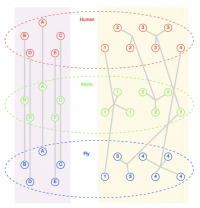 NOTICIAS
NOTICIAS
Worms, flies and humans... our common genomic legacy, key to understanding cell biology
CRG researchers contribute to a project that pointed out key sets of co-expressed genes that may be fundamental for animal cells.
- Scientists compared the transcriptome, the RNA complement of a species’ cell, of three very evolutionarily distant, yet well studied model organisms: the worm C. elegans, the fly D. melanogaster and the human H. sapiens. They found sets of genes that are co-expressed in each of the three species, all of them mainly involved in development.
- These results will be published next Thursday 28th August in the prestigious scientific journal Nature.
Genomes accumulate changes and mutations throughout evolution. These changes have resulted in a huge diversity of species and in different traits between us. But animal cells, whether they are from a fly or a human, work similarly: they have common molecular mechanisms.
Based on this premise, an international consortium with participation of scientists from the Centre for Genomic Regulation in Barcelona have compared the transcriptome (the RNA complement of a species’ cell) of different animal species. They used data from two big research consortia: the Encyclopedia of DNA Elements (ENCODE), which gathers information about human functional elements, and the Model Organism ENCODE (mod-ENCODE) which has the corresponding information about the fly and the worm. As a result, they have determined sets of genes that are likely to work together, independently of the organism in which they are found, and must therefore be essential for the whole animal kingdom.
“This paper is important since it is the first time such distant species have been compared in such an accurate manner”, explains Sarah Djebali, co-author of this paper and researcher at the CRG. The international team of collaborators performed and uniformly processed 575 RNA-seq experiments in many different tissues and in several developmental and perturbation conditions. “These findings give us a map of highly important regions of the genome that will guide the scientific community in future research projects related to cell biology and, in extension, to disease”, adds Dr. Djebali.
Apart from determining these key sets of co-expressed genes, the researchers have also observed that the three species have a similar proportion of transcription outside known coding and non-coding genes (coding meaning coding for a protein). Furthermore, they have seen that those sets of genes that seem to function together in the 3 animals are related to development, and confirmed the previous hypothesis that all animals go through a particular stage in embryonic development where the expression of the genes common to all animals is the most similar (called the “hourglass” hypothesis). Finally, comparing DNA and RNA states they have also been able to describe a model to quantitatively predict the gene expression levels from the DNA activity. A kind of universal model based on a single set of parameters independent of the organism you are looking at.

The role of the Computational Biology of RNA Processing group at the CRG led by Roderic Guigó together with scientists of the Yale University has been to provide advice on the human transcriptome, since the human RNA-seq data was first analysed at the CRG in the framework of the ENCODE project.
This is a new example of how bioinformatics is a crucial contributor to biomedical research.
Reference paper: Gerstein, M.B. et al. Comparative Analysis of the Transcriptome across Distant Species. Nature (August 28 2014) DOI: 10.1038/nature13424
For further information and interviews, please contact:
Laia Cendrós – Press Office – Centre for Genomic Regulation (CRG)
Phone: +34 93 316 02 37 – Cell Ph: +34 607 611 798 – e-mail: laia.cendros@crg.eu

